Ever wonder how many guitar strings are on a typical guitar? Both acoustic & electric guitars typically have 6 strings. The top 3 thinner strings usually “plain strings” while the lower 3 strings are usually thicker & are wrapped or “wound”.
When holding the guitar, string 1 is the thinnest & the thickest wounded string is number 6.
That’s the short answer, but historically, stringed instruments have been all over the place in terms of number of strings. We can see some lutes with as little as 4 & up to 35 during the baroque era.
As far as the guitar goes, they’ve generally been six strings since the 1700’s. In the modern era however, we’ve pushed the envelop & have brought forth the “Extended Range Guitars” & many experimental instruments.
Related: What is the tuning letter for each guitar string?
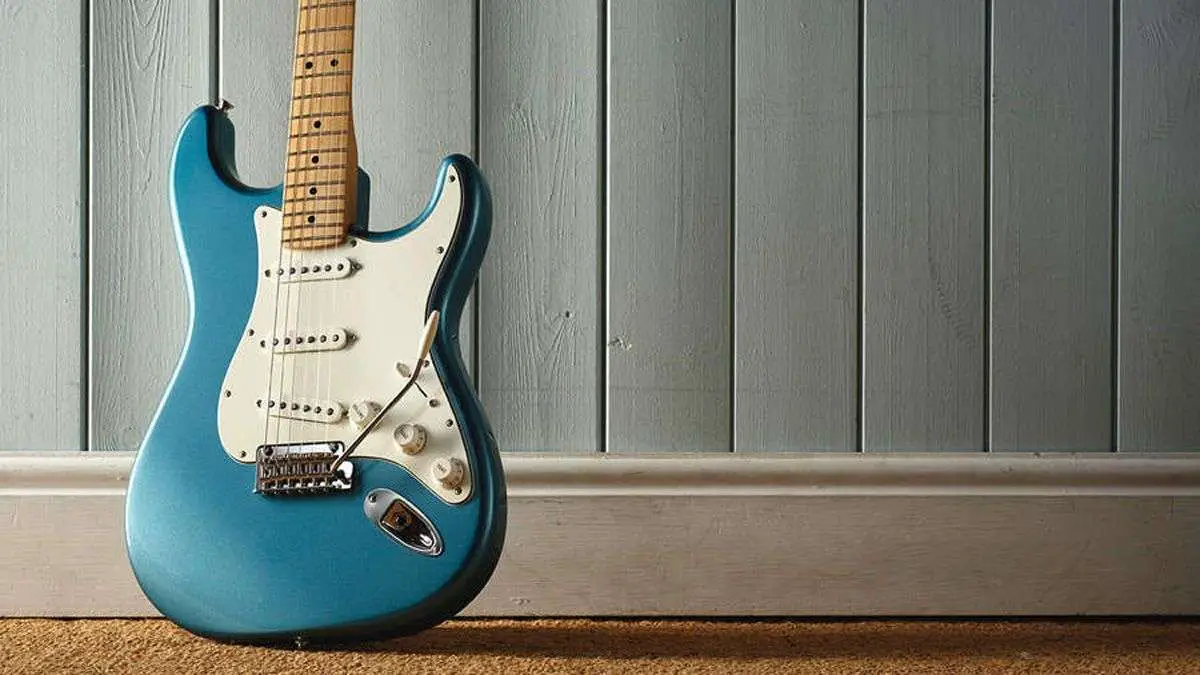
What Are The 6 Guitar Strings?
The six strings on a standard guitar (both acoustic & electric) are E (the thinnest string), A, D, G, B, and E (the thickest string).
All together it’s EADGBE which is considered the standard tuning for guitars. There’s also other tuning like tuning a half step down, dropped D tuning, and other alternate tunings.
How Many Strings Does a Classic Guitar Have?
A classic guitar, also known as a Spanish guitar, typically has six strings. The six strings on a classic guitar are numbered from the highest sounding string to the lowest sounding string, just like on a modern electric.
The highest string is usually the first string, followed by the second, third, fourth, fifth, and sixth strings. Each of these strings has a different gauge size & the lower strings are thicker and have a lower pitch than the higher strings, which are thinner and have a higher pitch.
It should also be noted that these classic guitars typically use nylon strings as opposed to bronze, copper, or steel. This gives them their signature sound & unique feel when played.
Acoustic guitars on the other hand are usually made with bronze & copper allows. Finally, the modern electric guitars use nickel plated steel for the most part.
How Many Guitar Strings Do Extended Range Guitars Have?
Classical & acoustic guitars with more strings than 6 have been around for ages, but here we are referring to the modern electric guitar. Extended range guitars are designed to offer more sonic versatility than traditional 6-string guitars.
The additional strings allow for a wider range of notes, which can give the player access to new sounds and textures.

Extended range guitars usually feature 7, 8, or 9 strings, allowing for lower and/or higher notes than a traditional guitar.
Additionally, extended range guitars are often equipped with special pickups, bridges, and other features to ensure the strings can be used in their full range.
The extra strings can open up the guitar-playing experience and provide the opportunity to explore new styles and techniques.
Related:
How to tune your 7 string guitars
How to tune your 8 string guitars
Here’s a list of extended range guitar players:
- Tosin Abasi
- Chris Broderick
- Dino Cazares
- Rusty Cooley
- Dave Davidson
- Paul Gilbert
- Matt Heafy
- Ihsahn
- Jeff Loomis
- Lucas Mann
- John Petrucci
- Devin Townsend
- Steve Vai
How Many Guitar Strings Do More Exotic Guitars Have
Venturing beyond the conventional six-string framework, exotic guitars with expanded string sets offer musicians a broader sonic canvas and intricate harmonic possibilities.
These instruments, though requiring a defter touch and more complex craftsmanship, unlock new musical dimensions and allow for a richer exploration of tonalities and textures.
Let’s delve into the world of multi-stringed guitars, from the seven-stringed Russian Gypsy guitar to the resplendent twelve-string classics, and uncover the diverse ways they enhance and challenge the art of guitar playing.
Russian/Gypsy Guitar
The Russian or “Gypsy” guitar is a distinct instrument that looks similar to a Spanish guitar but features a 7th string. This instrument was developed in the 19th century & traditionally played without a pick. It’s known for a particular sound that’s percussive, bright, and with resonant sustain. This is due partly due to the way that it’s played, using heavy strumming, snappy fingerpicking, and heavy palm muting.
The Gypsy guitar is comparable to the classical guitar we all know, however it does feature a slightly smaller body & wider fingerboard to accommodate the 7th guitar string. Being a 7 string also means it requires a tuning other than E standard so instead uses “open G” tuning. Today, the Russian Gypsy guitar is gaining recognition outside of Russia, with many musicians around the world becoming interested in this unique style of playing and incorporating it into their own musical creations. The instrument is also increasingly being used in various musical genres, such as folk, world music, and jazz.
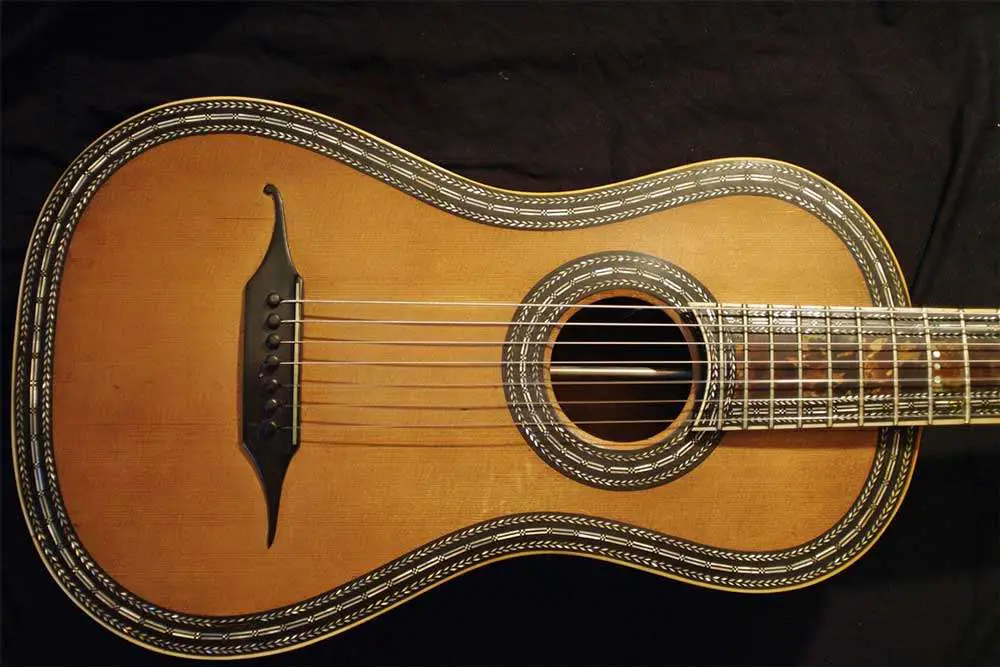
Mexican Guitarra Séptima
In Mexican music, when one asks how many guitar strings are on a guitarra séptima, you might think Siete! or Seven as the name implies! However the answer is quite unique: it sports 14 strings, which are grouped into pairs to function as a seven-stringed instrument.
This distinctive configuration allows for a rich, resonant sound that is characteristic of the instrument. Commonly found in the northern and central regions of Mexico, the guitarra séptima is a cornerstone in traditional musical styles such as ranchera, norteña, and bolero.
It frequently takes center stage in conjunto (ensemble) performances, harmonizing beautifully with other instruments like accordions, horns, and percussion. The guitarra séptima is also occasionally featured in mariachi music, where it shines in solo performances or as part of a small ensemble.
Characterized by its rapid and intricate fingerpicking, often enhanced by the use of a pick, the guitarra séptima is deeply ingrained in Mexico’s cultural and musical legacy. Its evolution is a reflection of Mexico’s historical musical journey, drawing from the Spanish vihuela and baroque guitar to become the cherished guitarra séptima that is integral to Mexican music today.
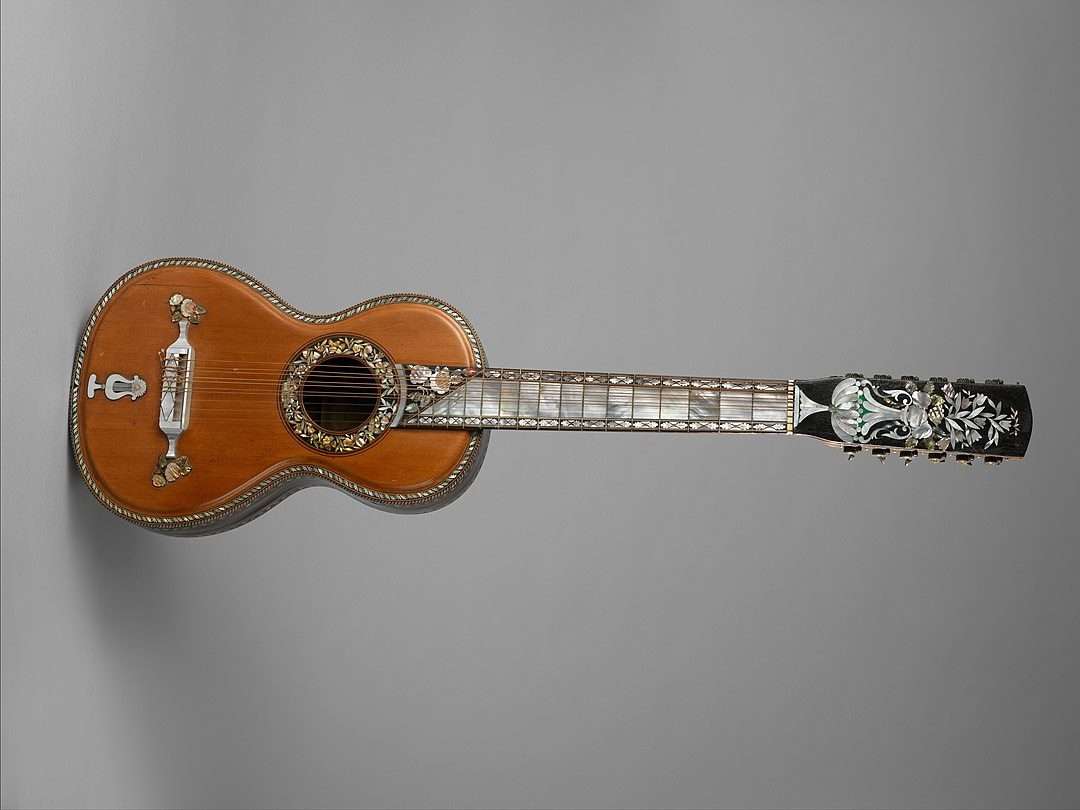
Brahms guitar
The Brahms guitar is a modern 8-string instrument similar to a cello. It’s basically a conventional guitar but with 2 added strings, 1 above & 1 below the standard E strings. This results in a tuning of AEADGBEA & features fanned frets for ease of playability.
Most important however, is that it features an external resonator box that the guitar attaches to. The instrument was developed by classical guitarist Paul Galbraith (shown in the video below) in collaboration with luthier David Rubio in 1994. The idea was originally conceived by Galbraith who wanted to use it specifically to perform Johannes Brahms’ Theme & Variations (Opus 21).
Related: Tuning an 8 String Guitar
Yepes 10-String Guitar
The Yepes 10-string guitar, often hailed as a revolutionary expansion of the classical guitar’s range, was meticulously conceived to access resonances and overtones beyond the reach of traditional six-string instruments.
Its unique tuning system, which extends the bass register, was developed by Narisco Yepes in collaboration with the luthier José Ramírez III, aiming to restore lost sonorities of ancient music that standard guitars could not produce.
This instrument’s profound impact on classical guitar music is evidenced by the specialized repertoire composed for it, including works by notable composers such as Toru Takemitsu and Maurice Ohana, further enriching the expressive capabilities of the guitar.

BC Rich “Bich 10”
The BC Rich “Bich 10” stands as a paragon of innovative guitar design, its ten-string configuration offering a fuller, more harmonically complex sound that pushes the boundaries of traditional electric guitar capabilities.
The instrument’s pioneering electronics, featuring an array of switches and coil taps, provide players with unparalleled control over tone and texture, making it a versatile choice for the experimental musician.
Esteemed by guitar aficionados for its aggressive aesthetics and robust construction, the Bich 10 has carved out a niche among iconic guitars and is revered for its role in shaping the sound of genres that demand a powerful sonic presence.
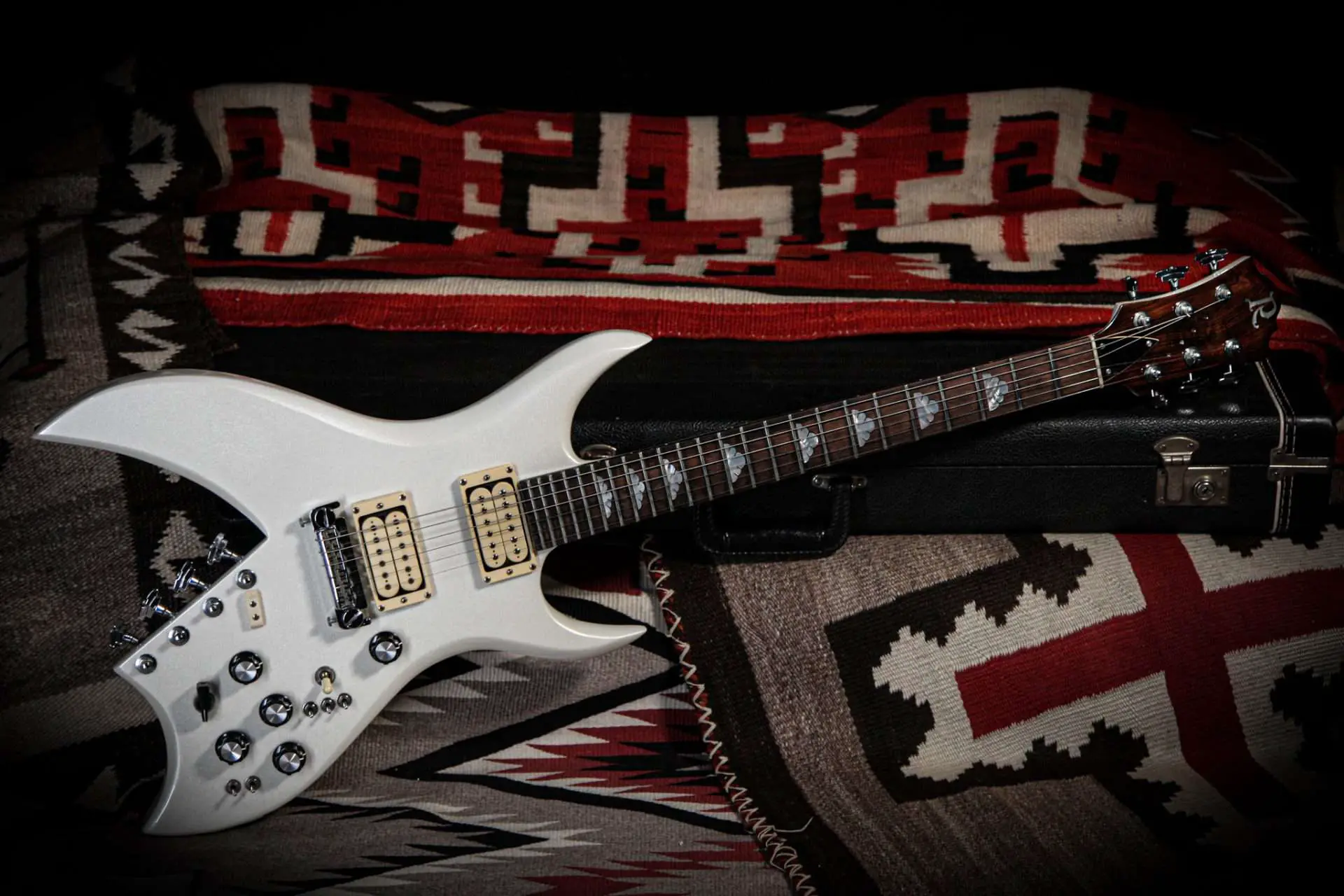
12 String Guitar
A classical 12-string guitar is an acoustic guitar with 12 strings instead of the standard 6. The strings are divided into six courses, each with two strings tuned to the same pitch. The first three courses are usually tuned in unison, while the last three are tuned in octaves.
Due to the doubling of strings, the 12-string guitar produces a rich, full sound with a natural chorus effect. It’s popular in folk, rock, and country music, and it’s also used in classical guitar music.
A classical 12-string guitar is built similarly to a standard 6-string classical guitar, with a flat top, curved back, and a wider neck to accommodate the additional strings. Strings are typically made of steel or nylon, depending on the preferences of the player.
Related: How’s a 12 string guitar tuned?
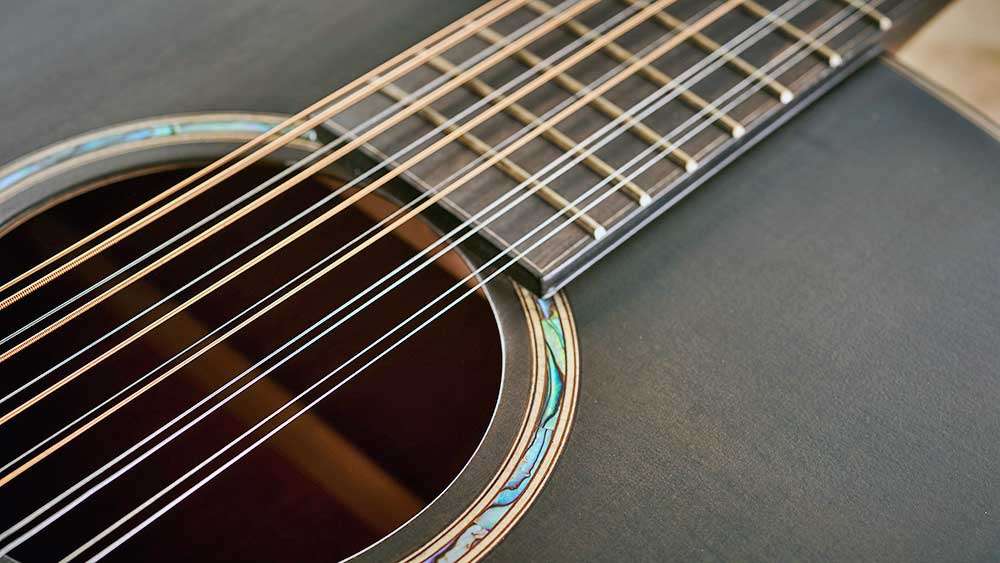
Can A Guitar Have 20 Strings?
When guitar enthusiasts ask “how many guitar strings can a guitar have”, the answer can be quite astonishing.
While most guitars feature six strings, there are extraordinary instruments like the Medusa Guitar by luthier Linda Manzer, which boasts an incredible 52 strings. Showcased at the Holy Grail Guitar Show, Manzer’s Medusa Guitar is a testament to the limitless creativity in guitar craftsmanship.
Although 20-string guitars are less common than the Medusa, they do exist and are often the result of custom work by individual luthiers or specialized guitar manufacturers.
These extended-range instruments offer a kaleidoscope of tonal possibilities, but they also present challenges in terms of playability and tuning. The necessity for a wider neck to accommodate however many strings there are may not suit all players, and mastering these guitars often requires specialized playing techniques and innovative approaches to music composition, particularly in genres that thrive on experimental sounds like metal, jazz, and avant-garde music.
How Many Strings Does The Bass Guitar Have
The four-string electric bass guitar, tuned E-A-D-G, is the bedrock of the bass family, revered for its foundational role in rhythm sections across myriad musical genres. Its design, largely unchanged since its inception in the early 1950s by Leo Fender, remains the most prevalent and accessible for bassists worldwide.
In pursuit of expanded harmonic depth and versatility, the five-string bass, with its additional low B string, and the six-string bass, which adds both a low B and a high C, have gained popularity. These extended-range basses cater to players seeking to explore the outer reaches of the tonal spectrum in complex musical settings like jazz fusion and progressive metal.
While four to six-string configurations dominate the bass landscape, there exist more exotic variants with seven, eight, or even up to ten or more strings, often custom-built for adventurous bassists pushing the limits of the instrument.
These multi-stringed behemoths, like the rarefied Conklin Sidewinder 7-string or the Ibanez Ashula with its hybrid fretted and fretless design, offer a broader palette for sonic exploration. However, such instruments are less common due to their specialized nature, increased physical demands on the player, and the complexity of their construction.
Conclusion
How many guitar strings does it take to paint a musical masterpiece? The answer is as varied as the artists who wield these instruments, each adding their unique stroke to the canvas of sound.
From the steadfast six-string that has been the standard bearer since the 1700s to the sonorous twelve-string echoing with its chorus of harmonies, guitars offer a spectrum of possibilities.
The evolution of the guitar, marked by both innovation and tradition, has expanded the question of “how many guitar strings” to include extended range and exotic instruments, pushing the boundaries of what we can create musically.
Whether you are drawn to the classic six strings or intrigued by the vast tonal landscapes of multi-stringed guitars, what will your answer be to how many guitar strings are needed for your musical expression?
